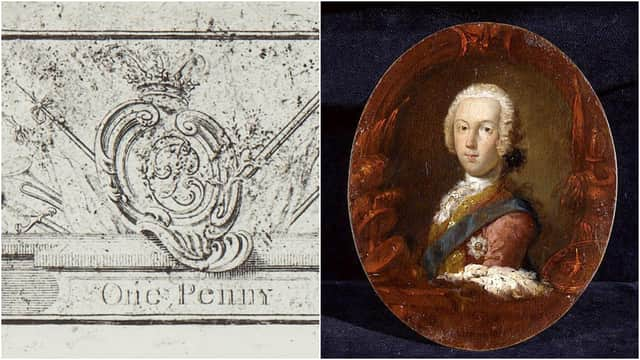Rare Jacobite bank notes set to go under the hammer


The engraving plate was commissioned by "Young Pretender" Charles Edward Stuart in 1746 to produce money to pay his armies and fund the continuation of the Jacobite cause, to restore the Stuart monarchy.Before the money could be printed, the Jacobites suffered their crushing defeat at Culloden, near Inverness, and the copper plate was lost during Charles' flight.Rediscovered in the 19th century, the plate was used in 1928 to create a small number of prints to support the new West Highland Museum, founded in Fort William, in 1922.Now, a rare set has been created for the first time in nearly a century to mark the museum's centenary and raise funds for its re-development and conservation plan.The first of 22 sheets will be offered at Lyon & Turnbull auctioneers in Edinburgh next Wednesday, when the banknotes are expected to fetch £600-800 for the museum.The sheet printed by experts at Edinburgh Printmakers shows four banknotes in one penny, two pence, three pence and six pence denominations, with four other notes left blank.Each note shows intertwined initials CP (Prince Charles) within a swept cartouche featuring thistles and crowned Prince of Wales Feathers.Charles ordered the rectangular copper plate after arriving in Inverness in 1746, short of funds, and commissioned the Orcadian artist and engraver Robert Strange -- a member of Prince Charles’ Lifeguards regiment -- to produce the money in the different denominations. Strange, who would later describe in his diaries how difficult this was with limited materials, had a printing press constructed in Inverness. He engraved the plate, and was about to start production when Charles' army was crushed on 16 April 1746.Dr Chris Robinson, director at the West Highland Museum, said: "Charles was waiting for money from France but it arrived too late. As a future king, he determined the right to have printed paper money to pay his troops, which he would honour when the Stuarts were back on the throne."But the money was never printed and the plate was found 90 years later in a bog close to an old ford on the River Spean, which Bonnie Prince Charlie crossed on 28 August 1746 during his flight after Culloden. It is possible that Charles carried the plate around with his baggage, but it was either lost or discarded here."It is very exciting to think these are the actual banknotes created for the anticipated Jacobite world of the mid-18th Century."Alastair Clark, Studio Director at Edinburgh Printmakers, who struck the prints and advised throughout the process, said: "In all my time at Edinburgh Printmakers this is probably the most unusual print I have ever worked on."The request came in by email during lockdown marked 'Strange plate'. I certainly thought it was curious and unusual but then realised it was a plate engraved by Sir Robert Strange."The historical significance of these notes as Jacobite currency was fascinating so I was delighted to have the opportunity to work with the original plate 275 years later."